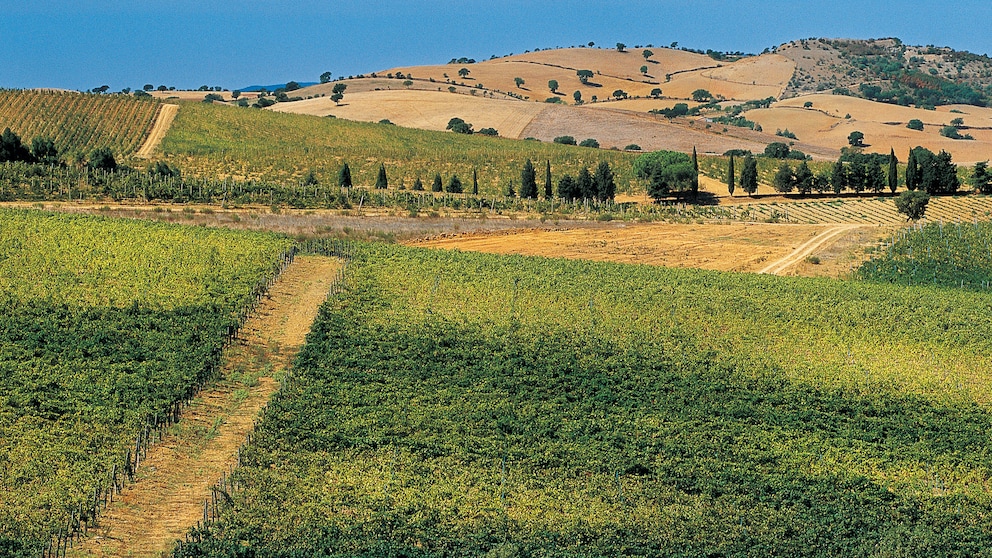March 5, 2025, 9:08 am | Read time: 5 minutes
Wild and romantic landscapes with wooded hills, meadows, and marshes, but also fantastic beaches and turquoise blue sea — the Maremma in Tuscany is a real tip for hikers, cyclists, beach vacationers, and anyone looking for peace and quiet far away from mass tourism.
There were times when the Maremma was notorious. The landscape in Tuscany was so swampy that it was repeatedly ravaged by malaria. Of course, this did not help its reputation. Although the Etruscans, who settled in Populonia, Vetulonia, and Roselle, had already begun to drain the area with the help of a canal system, their efforts only paid off for a short time. In Roman times, the Maremma was once again swampy and uninhabitable.
Prefer to soak up tips about Maremma through your ears rather than your eyes? Tune into this episode of our podcast ‘Around the World in 5 Minutes’ for an auditory adventure.
It took many centuries before anyone dared to drain the Maremma again. The nearby cities of Pisa and Siena turned it down — for them, coastal regions were only of interest as port bases. It was not until the 19th century that the Grand Dukes of Tuscany succeeded in largely draining the area, also with a canal system.
Table of Contents
Maremma — a Vacation Destination for Nature Lovers
Today, nestled between Follonica and Orbetello near the Monte Argentario peninsula and flanked by Castell’Azzara, Monte Amiata, and Montieri, the Maremma beckons as a serene getaway for travelers who favor the tranquility of a farm stay over the bustle of a large hotel. Here, you can encounter the region’s iconic domestic animals: the resilient Maremmano horse and the majestic white Maremman shepherd dog, descendants of the ancient guardians of local sheep flocks.

Beaches in the Maremma
Nevertheless, nobody has to miss out on the beach in the Maremma. And they shouldn’t, because the beaches are not only very attractive but also particularly clean. Popular spots include the unspoiled Maremma beach in Marina di Grosseto, the enchanting Cala Violina in Saclino, and the inviting sands of Follonica, Castiglione della Pescaia, Talamone, and Principina di Mare. To name just a few. In many places, however, you have to pay quite a lot before you can lay your beach mat on the sand.

Parco Regionale della Maremma
Fortunately, the marshlands have not yet completely disappeared from the Maremma. Today, these areas are retreats for countless bird species, some of which have become rare. The Parco Regionale della Maremma, also known as the Parco dell’Uccellina, was established in 1975 and covers an area of almost 10,000 hectares with pastures, pine forests, marshes, the Monti dell’Uccellina mountains with wild macchia vegetation and holm oak forests. Some areas are fully protected reserves, and others can be visited.

Nature enthusiasts will marvel at the sight of porcupines, wild cats, eagle owls, and stone martens and can witness the spectacle of the annual bird migration (note that there are restrictions for hikers during this period). At the mouth of the Ombrone river, you can visit the ancient facilities that drain the Maremma and learn fascinating facts about the marshland on a nature trail. Should you wish to explore the park, you can steer your way to the information centers in Alberese and Talamone. There is also a bus service for hikers from Alberese.
Sights from the Time of the Etruscans
And, of course, there are also places to see here that were settled by the Etruscans. Populonia near Livorno, for example, where today, you can see an archaeological park including an acropolis, cave tombs, ancient blast furnaces for smelting iron ore, and much more. The necropolis of San Cerbone, where tombs from the 7th to 6th centuries BC can be seen, is magnificent. The town of Populonia itself is a gem, ensconced within medieval walls and crowned by a castle that whispers tales from the 15th century.

Vetulonia, which is now part of Castiglione della Pescaia, is also worth a visit. Here, the echoes of the Etruscan era are palpable, with tombs and house ruins dotting the landscape and an archaeological museum that showcases spectacular grave finds. Further traces of the Etruscans can be found in Roselle, around eight kilometers northeast of Grosseto. An important Etruscan city once stood here, traces of which are still clearly visible. Roman buildings — from the amphitheater and temples to the thermal baths — have also been preserved. If you would like to know more about the Etruscans, to whom Tuscany even owes the cultivation of wine, you should visit the Archaeological Museum in Arezzo, which has a wealth of information and finds.
The Via Aurelia, the Aurelian Way, whose construction was ordered by Gaius Aurelius Cotta in 241 BC, is also a reminder of the Romans in Maremma. Once a vital artery stretching from Rome to Pisa, the Via Aurelia now lives on in name alone, having transformed into a modern thoroughfare.

Centuripe in Sicily What do you recognize in this village?

Overview The 9 Most Charming Places on Lake Garda

Hidden Gem in Italy This City Is as Beautiful as Florence — Only Without the Tourist Crowds
Map with beaches and sights in the Maremma
(Text: Silke Böttcher)


